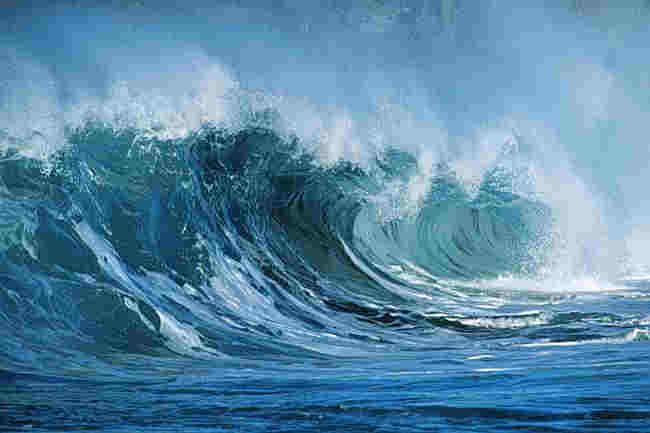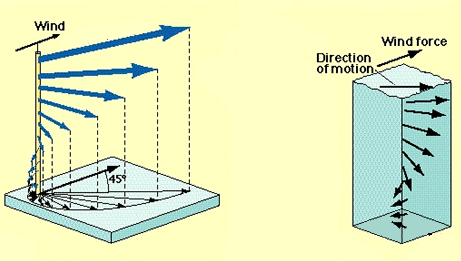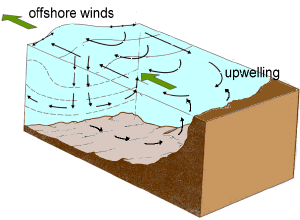|
|
|
||
 OBJECTIVES: · Exploring and identifying water masses and currents. · Discovering how different water masses cause circulation throughout the oceans. VOCABULARY:
MATERIALS:
ONLINE
READINGS:
https://msnucleus.org/membership/html/jh/earth/oceanography/lesson5/oceanography5a.html
BACKGROUND: The
oceans are always moving. The movement is graceful and subject to the
principles of fluid motion. Fluid motion refers to the response of liquid
to forces of wind, density, and rotation of the Earth in space. Locally
you must include factors such as topography and tidal forces. The
waters of the oceans are not homogeneous. There are ocean masses
that move as units, called currents. The ocean’s movement is predictable
based on mathematical modeling. The model takes into account many factors
that control currents not only on the surface but with depth
Coriolis does not alone explain movements, but other
factors not related to movement such as density of water, wind and local
submarine topography need to be included.
W
Wind is actually a bizarre phenomenon. It can change
quickly depending on the balance of heat. A mountain can stop wind and add
to the chaos of wind motion. Wind produces energy throughout the water
column in a predictable pattern called the Ekman spiral. The
transfer of wind energy from the atmosphere to the waters can cause motion
far from where the energy first entered the system
Temperature and density can define a water mass.
Warmer water can hold more salt, and colder water holds less salt. Salt
water is more dense than fresh water of the same temperature. The salt
water will layer itself below the fresh water. Warm water is less dense
than cold water. So cold water will layer under warm water. Add the
combination of different amounts of salt and different temperature and you
have a layering effect in the water column. The world’s oceans are a
three-dimensional nightmare of layers of different water masses that can
move in different directions.
All
these reasons cause the movement of the oceans to spin into smaller
eddies. Please keep in mind that although this motion looks chaotic, it
really is responding to natural forces, which we can mathematically model.
Seawater density varies from place to place because it is affected by
salinity and temperature. High salinity makes water denser. This is
because there is more salt packed into the water.
.
PROCEDURE:
INTRO: Ask students what have
you learned about that causes climate patterns so far (just get a few such
as the water cycle, wind
patterns, coriolis effect, different levels of solar radiation by
latitude, land vs. sea cooling and heating, high and low pressure air
masses). Today we talk about
ocean currents and the impact of ocean currents on global climate.
Go over
powerpoint presentation on Ocean Movements (slides 1 to 8)
1.
First slide
review Coriolis effect (earth rotation) covered last time
2.
Second slide.
Remind the students about how the barriers to ping pong balls from
prior lab. Did the ping
pong balls just stop or move to the side or bounce back?
Underwater has barriers too that influence ocean currents.
Ask them to name some.
(example, under water ridges, the continents, ice sheets, etc.)
3.
Slides 3 to 7
Differences in the density of water produces water currents.
Cold, high saline water is very dense. When icebergs form,
that means fresh water is taken
out of the system, concentrating the salt in the water. This water is so
dense it drops to the bottom and remains there for hundreds of years, as
it travels on the bottom. The diagram shows "new" water starts in the
North Atlantic and moves along the bottom. The cold water warms up slowly
and emerges in the Pacific Ocean only to start circulating through
different routes.
4. Watch the NASA lab on the
water currents and note how the land masses change the direction of the
currents.
https://pmm.nasa.gov/education/videos/thermohaline-circulation-great-ocean-conveyor-belt But there is
another aspect that is affecting the currents and that is water density.
5. Watch video
https://www.youtube.com/watch?v=UuGrBhK2c7U
covers thermohaline conveyor
After video what does thermohaline mean (thermo means heat and haline
means salt)
Now look at another video of how changes in our conveyor belt can affect
our climate. (Al Gore short video)
https://www.youtube.com/watch?v=kSCT1UAfuzo
6. To recap, dense water
sinks below less dense water. In the ocean the two main drivers are
saltiness and temperature.
This is the principle that drives the deep ocean currents that circulate
around the world. A combination of high salinity and low temperature near
the surface makes seawater dense enough to sink into the deep ocean and
flow along the bottom of the basins.
FIRST
ACTIVITY—density timers (5 to 10 minutes)
1.
Give students a
density timer with a warning not to shake the timer.
Shaking ruins them.
Ask them to look at the 3 different liquids and see if they can figure out
which is denser than the other.
(The first color liquid to drop is the most dense--heavier.)
2.
Put the density
timer on its side and see if you can get the bottom layer to come upward
by gently rocking it back and forth.
The sides of the timer are analogous to dense ocean currents
hitting underwater barriers forcing the bottom water upward (upwelling).
Ocean currents are driven by variable density layers in the oceans,
wind at the surface, and bathymetry (underwater barriers).
SECOND ACTIVITY
(20 minutes) Making a
water salinity density column
PREPARATION:
Place sets of large test tubes at the tables, containers of water,
measuring spoons, a dish of salt and a discard bucket.
1.
Students will work in teams of
two. Each team gets two
large test tubes one that says fresh on top and one that says salt.
They should fill both test tubes with fresh water to the second
from the bottom line on the test tube.
2.
Ask them to swirl
the test tubes to see if they can produce a “tornado”.
Take the salt test tube and ask them to use the measuring spoons
and add 1 ml of salt. They
should reapply the cap tightly and then shake
the test tube around until all the
salt is dissolved. When it is
all dissolved, ask them to swirl the test tube and look at the “tornado”.
Is it easier to form?
Ask them to compare it to the freshwater one.
3.
Ask them to add
another 1 ml of salt and repeat all steps.
4.
Ask them to keep
adding salt until they have added 5 ml total.
5.
Ask students which
is denser, the water with salt or without (salt is denser)
Denser water behaves a bit differently.
6.
Docent should then
go around and add different food coloring colors to salt and fresh water
tubes. Just 1 or 2 drops of the color will do.
It works best if the colors are contrasting (see photo). Students should
note the difference in how the food coloring reacts to the two tubes.
In the fresh water, the food coloring sinks and starts to spread
out. In the salt water the
food coloring just sits on the top.
Ask the students why they think there is a difference (the food
coloring is more dense than fresh water and sinks in fresh water and less
dense than the salty water so stays on the surface).
7.
Students should
now swirl the tubes to mix the food coloring evenly.
Ask students to predict what will happen when there is a salt water
layer and a fresh water layer are combined (salt water layer should be at
the bottom.) 8.
To make layered salt water, students will take the fresh water tube
and hold it at an angle. Fill
the pipette with the salt mixture, place the pipette in the fresh water
tube so the tip is near the bottom and
SLOWLY add the salt water to
the fresh. (Since the test tubes have round bottoms, if they pour the salt
water or squeeze the pipette too fast the salt water will upwell quickly
and the layers will mix.)
They should keep doing this until they get about half of the salt water in
the fresh water tube. If they
do this correctly they will get two distinct layers that do not mix even
when you move the tube gently back and forth.
You should
demonstrate this technique to them before they start. If they go too
fast and mix their layers, let them dump out their freshwater test tube
and try again.
9.
If they have time
and want to try to make a third layer, they can make a highly salty cold
water mixture which is denser than the other salty water.
To make super salty cold water put in the regular amount of fresh
water, add 10 ml of salt and one or two ice cubes.
They should shake it vigorously for a minute or so the mixture gets
quite cold. They can leave
this cold mixture clear or add a contrasting food color and add it
carefully to the bottom of the test tube with the salt and fresh layers
using the pipette. This layer
will remain at the bottom. At the end,
students can shake their layered test tubes.
It will all mix. If
there is enough turbulence, the layers will mix and not separate. 10
Review. What other
layers do they think they could form?
Where would warm fresh water go?
How about cold fresh water?
9. Review
at the end that ocean currents start by cold salty water sinking to the
bottom. These sinking water
masses help mix the entire ocean and take gases from the atmosphere to the
deep ocean. (For more info
you can go to
https://timescavengers.blog/climate-change/ocean-circulation-stratification/) 10.
CLEAN UP -- At the end, students should dump out their test tubes
and rinse them with water only (NO SOAP) to be ready for the next class. |
|||

 ind also moves water around, especially the upper portions of the water
column. However, wind is generally moving in the same direction caused by
the rotation of the Earth, so they "add" forces. In areas where land and
water meet, the direction of the wind is controlled by temperature
differences of the land and water. Strong winds can influence the movement
of coastal waters.
ind also moves water around, especially the upper portions of the water
column. However, wind is generally moving in the same direction caused by
the rotation of the Earth, so they "add" forces. In areas where land and
water meet, the direction of the wind is controlled by temperature
differences of the land and water. Strong winds can influence the movement
of coastal waters. Bottom topography can act as a barrier to water
masses already in motion. If a cold saline water mass is moving along the
bottom and "hits" a mountain it would be forced upwards. This is one form
of upwelling. This would displace the water masses above it, causing lots
of movement.
Bottom topography can act as a barrier to water
masses already in motion. If a cold saline water mass is moving along the
bottom and "hits" a mountain it would be forced upwards. This is one form
of upwelling. This would displace the water masses above it, causing lots
of movement. 


